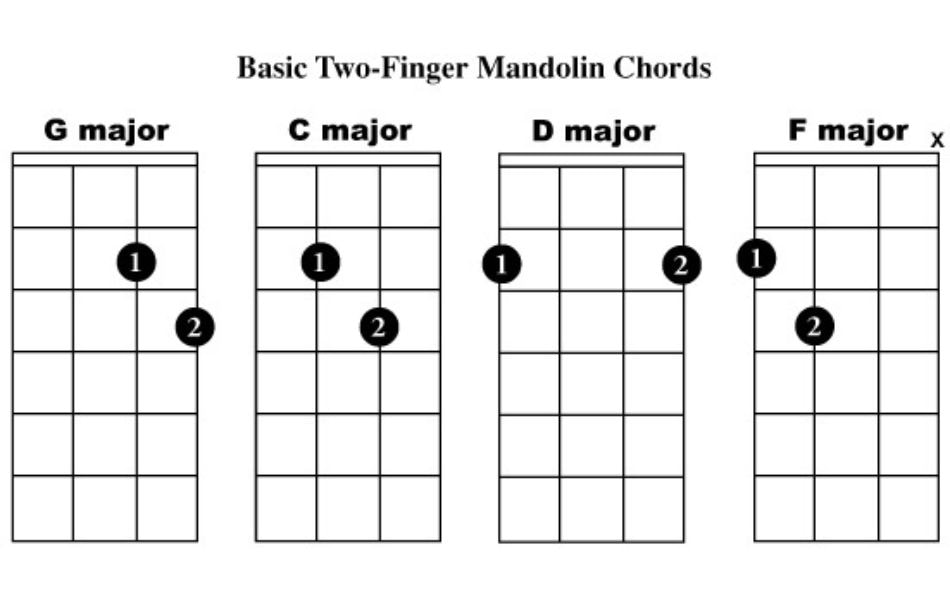Mastering the mandolin opens up a world of melodious possibilities. One of the best ways to start is by understanding and practicing basic chords. In this tutorial, we’ll delve into the realm of 2-finger mandolin chords, an excellent starting point for beginners. These simplified chords are not only easy to learn but also essential for building a strong foundation in mandolin playing.
Contents
What is 2-finger mandolin chords
2-finger mandolin chords refer to a chord that can be played using just two fingers on the fretboard of the mandolin. The mandolin is a stringed musical instrument with four strings tuned in fifths (G-D-A-E). Two-finger chords are typically more straightforward and easier to play, making them ideal for beginners and quickly transitioning between chords.
Role of 2-finger chords
Two-finger mandolin chords, or similar simple chord formations on other instruments, serve several purposes:
- Ease of Learning for Beginners
Simple chords like these are excellent starting points for beginners learning to play the mandolin. They are easy to memorize and play, providing an initial foundation for more complex chords.
- Smooth Transitioning
In many songs, musicians need to switch between chords quickly and smoothly. two-finger mandolin chords allow for faster transitions, enabling beginners to play songs with minimal finger movements.
- Basic Accompaniment
Two-finger chords offer a way to provide basic accompaniment to a melody. They can be used to create a harmonic background, allowing beginners to play along with songs and other musicians.
- Practice and Skill Building
Starting with simple chords helps beginners build strength and dexterity in their fingers, setting the stage for more complex chord formations as they progress in their musical journey.
These chords on the mandolin is the same as open chord such as open c chords and open e chord on the guitar. The naming conventions might differ slightly depending on the musical instrument, but the fundamental idea remains consistent: offering easily accessible entry points for learning and engaging with music.

How to play mandolin chords 2-finger
Playing 2-finger mandolin chords involves positioning your fingers on specific frets and strings to produce a chord. Here are step-by-step instructions for playing common two-finger mandolin chords:
G Major Chord:
- Place your index finger on the 2nd fret of the A string (second thinnest string).
- Place your middle finger on the 3rd fret of the E string (thickest string).
D Major Chord:
- Place your index finger on the 2nd fret of the E string.
- Place your middle finger on the 3rd fret of the B string (third thinnest string).
A Major Chord:
- Place your index finger on the 2nd fret of the D string (second thickest string).
- Place your middle finger on the 2nd fret of the G string (third thickest string).
C Major Chord:
- Place your index finger on the 1st fret of the B string.
- Place your middle finger on the 2nd fret of the D string.

Compare 2-finger mandolin chords to basic mandolin chord
Two-finger mandolin chords are simplified versions of basic mandolin chords. The main difference lies in the finger positions and the number of fingers used to form the chords.
Two-Finger Mandolin Chords
As the name suggests, these chords are formed using only two fingers. They are simpler and easier to play, making them ideal for beginners and for quick chord transitions. Examples include G Major, D Major, A Major, and C Major chords.
Basic Mandolin Chords
Basic mandolin chords can involve more than two fingers and may require intricate finger positions. These chords encompass a broader range of notes and may have a richer, fuller sound compared to two-finger chords. Examples include more complex open chords, barre chords, and variations that use three or four fingers.
In summary, two-finger mandolin chords are introductory, beginner-friendly chords that allow individuals to start playing and transitioning between chords with ease. Basic mandolin chords, on the other hand, include a wider variety of chords that may require more finger dexterity and provide a more comprehensive harmonic range.
The choice of which to use depends on the player’s skill level, the complexity of the song, and the desired sound. Beginners often start with two-finger chords and gradually progress to mastering more intricate and fuller-sounding basic mandolin chords.
In conclusion, mastering 2-finger mandolin chords is an essential stepping stone in your musical journey. These simplified chords provide an excellent starting point, enabling you to play a variety of songs and gradually progress to more complex chord formations.
